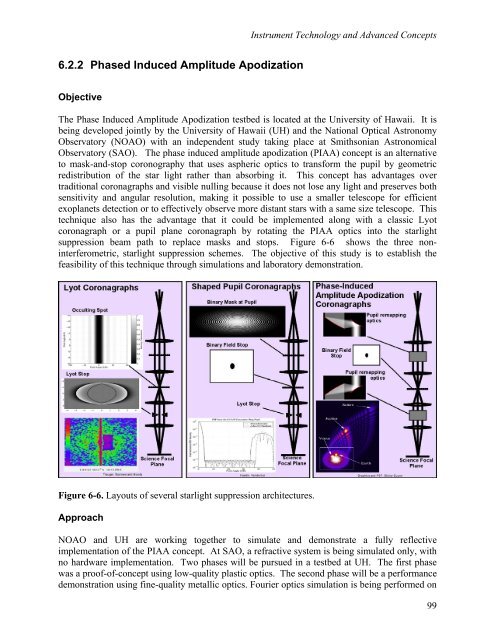TPF-C Technology Plan - Exoplanet Exploration Program - NASA
TPF-C Technology Plan - Exoplanet Exploration Program - NASA
TPF-C Technology Plan - Exoplanet Exploration Program - NASA
You also want an ePaper? Increase the reach of your titles
YUMPU automatically turns print PDFs into web optimized ePapers that Google loves.
Instrument <strong>Technology</strong> and Advanced Concepts<br />
6.2.2 Phased Induced Amplitude Apodization<br />
Objective<br />
The Phase Induced Amplitude Apodization testbed is located at the University of Hawaii. It is<br />
being developed jointly by the University of Hawaii (UH) and the National Optical Astronomy<br />
Observatory (NOAO) with an independent study taking place at Smithsonian Astronomical<br />
Observatory (SAO). The phase induced amplitude apodization (PIAA) concept is an alternative<br />
to mask-and-stop coronography that uses aspheric optics to transform the pupil by geometric<br />
redistribution of the star light rather than absorbing it. This concept has advantages over<br />
traditional coronagraphs and visible nulling because it does not lose any light and preserves both<br />
sensitivity and angular resolution, making it possible to use a smaller telescope for efficient<br />
exoplanets detection or to effectively observe more distant stars with a same size telescope. This<br />
technique also has the advantage that it could be implemented along with a classic Lyot<br />
coronagraph or a pupil plane coronagraph by rotating the PIAA optics into the starlight<br />
suppression beam path to replace masks and stops. Figure 6-6 shows the three noninterferometric,<br />
starlight suppression schemes. The objective of this study is to establish the<br />
feasibility of this technique through simulations and laboratory demonstration.<br />
Figure 6-6. Layouts of several starlight suppression architectures.<br />
Approach<br />
NOAO and UH are working together to simulate and demonstrate a fully reflective<br />
implementation of the PIAA concept. At SAO, a refractive system is being simulated only, with<br />
no hardware implementation. Two phases will be pursued in a testbed at UH. The first phase<br />
was a proof-of-concept using low-quality plastic optics. The second phase will be a performance<br />
demonstration using fine-quality metallic optics. Fourier optics simulation is being performed on<br />
99
















